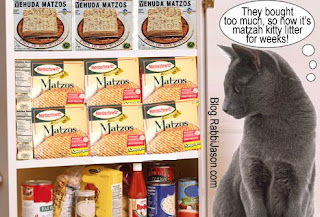James Besser, Washington Correspondent and New Media Editor of The New York Jewish Week, asked me to come up with a Top Ten list of uses for leftover Passover matzah. But being busy trying to catch up with post-Passover work, I was only able to come up with five. (Who am I kidding? Even if I had a lot more free time I couldn’t have come up with ten.)
Here’s James Besser’s post, but if you really want to laugh out loud check out last year’s hilarious YouTube video “20 Things To Do with Matzah” by Michelle Citrin and William Levin.
Five uses for leftover matzah
Okay, you miscalculated, and you have a few extra boxes of Passover matzah cluttering your cupboard. Maybe a few dozen.
And let’s face it: if you have to choke down another bite of matzah, you’re going to hurl. So what to do with the leftovers?
We asked Jewish Week blogger Rabbi Jason Miller, and he offered these “helpful” suggestions – tongue firmly in cheek, maybe stuck there by all the matzah goo:
– Give it to a blind person to read
– Crumble, add water and fill in the cracks in the sidewalk
– Use it as packing material
– How about playing catch with a square Frisbee?
– Crumble up for Shavuot Blintz topping

